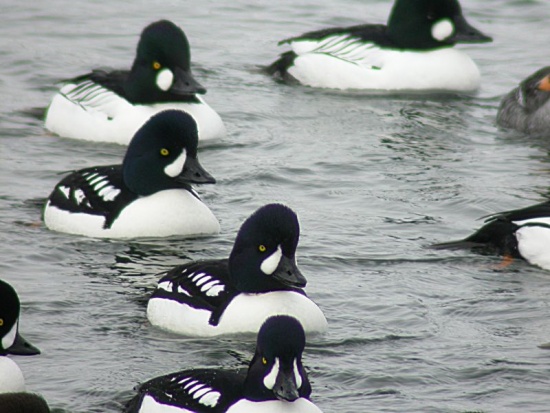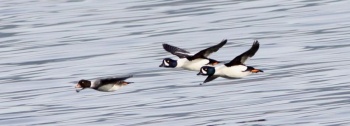
Photo by snowyowl
Location: Prince Edward Island, Canada, February 2005
- Bucephala islandica
Identification
43-48cm
Males (breeding):
- Head with a purplish gloss, white crescent at the front of the face which extends above eye.
- Bill black with hook
- Neck and underparts to vent white
- Upperparts and rear including vent black. Black "boa" or "spike" extends downwards at the base of the neck
- Secondaries, tertials and scapulars white, showing as more or less distinct patches (bordered by black fringes)
Females:
- Head light to medium brown
- Bill black, hooked, with a variable pinkish to orangy patch
- Neck white
- Body including most of the wings greyish with slight scalloping
- Secondaries/tertials white. This may show as a patch at the rear when at rest
Similar Species
Similar to Common Goldeneye. Different in:
- beak shape. Shorter than Common, "dinky"
- head shape. Often appears more rounded than Common; actually elongated from rear base to forehead
- eye colour subtly different. Paler than Common, making it flat yellow in the male and with a greenish tint in the female
- male head pattern. Bluish cf greenish in Common. White streak is elongated instead of rounded and reaches above eye
- male wing pattern. More extensive white on Common makes for more of a white panel. In Barrow's, scapulars (especially) appear as unconnected splodges
Distribution
A mainly North American duck, the only Western Palearctic breeding area is Iceland where a fairly common resident, especially in the Lake Myvatn area.
Elsewhere in Europe a vagrant or escape; recorded in the Faroes and Britain east to Sweden, Poland and northern Russia, north to Svalbard and south to Spain. Other reports have involved obvious escapes and until ringing recoveries show genuine vagrancy does occur then all reports of this species must be treated with caution. Icelandic birds are sedentary, remaining on breeding waters or moving to larger lakes nearby.
Any genuine vagrants in Europe are more likely to originate from the more migratory Canadian populations.
Taxonomy
Monotypic[1]
Habitat
Breeds on small lakes and rivers, some moving to larger freshwaters and sheltered coasts nearby in winter.
Behaviour
Diet
The diet includes aquatic insects, crustaceans and pond vegetation.
Breeding
They nest in tree cavities or in burrows or on the ground in scrub.
References
- Clements, JF. 2008. The Clements Checklist of Birds of the World. 6th ed., with updates to December 2008. Ithaca: Cornell Univ. Press. ISBN 978-0801445019.
- Wikipedia
- Collins Bird Guide ISBN 0 00 219728 6
Recommended Citation
- BirdForum Opus contributors. (2025) Barrow's Goldeneye. In: BirdForum, the forum for wild birds and birding. Retrieved 12 May 2025 from https://www.birdforum.net/opus/Barrow%27s_Goldeneye
External Links
GSearch checked for 2020 platform.1





